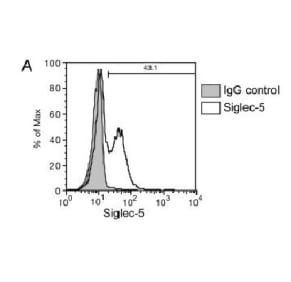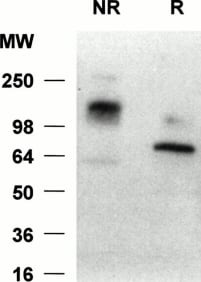Anti-SIGLEC5 [1A5]
Invented by Prof Paul Crocker from University of Dundee
Invented at University of Dundee
- Datasheet
- References (10)
- Inventor Info
Info
| Catalogue Number | 151589 |
| Applications | ELISA FACS IHC IF IP Fn WB |
| Antigen/Gene or Protein Targets | Siglec5 |
| Synonyms | Sialic Acid Binding Ig Like Lectin 5; Obesity-Binding Protein 2; OB-Binding Protein 2; CD33 Antigen-Like 2; SIGLEC-5; CD33L2; OBBP2; Sialic Acid-Binding Immunoglobulin-Like Lectin 5; CD170 Antigen; |
| Reactivity | Human |
| Relevance | The Siglecs are a family of membrane bound lectins (of the immunoglobulin superfamily) that bind sialic acid and mediate cell-cell interactions. Siglec5 (CD170) is a member of the recently-described human CD33-related siglec subgroup of sialic acid binding Ig-like lectins and is expressed on myeloid cells of the hemopoietic system. Similar to other CD33- related siglecs, Siglec-5 contains two tyrosine based motifs in its cytoplasmic tails implicated in signalling functions. The antibody cross reacts with Siglec14. |
| Host | Mouse |
| Immunogen | Siglec-5-Fc protein, containing entire extracellular region of siglec-5 fused with the Fc region of human IgG1 |
| Positive Control | Siglec5 transfected CHO cells. Apart from Siglec14 (Angata T et al. 2006 FASEB J. 20:1964-73. PMID: 17012248), non-cross-reactive with panel of other Siglec proteins, either expressed on CHO cells or as recombinant proteins. |
| Subclass | IgG1 |
| Myeloma Used | Sp2/0-Ag14 |
| Recommended Growing Conditions | DMEM + 10% FetalClone I + 1% penicillin/streptomycin |
| Notes | Recommended dilution for FACS: Cells (1x10^6) should be incubated with 1ug of antibody/100 ul in 1% BSA in PBS for 30–60 min on ice (Nguyen et al., 2006). |
| Research Area | Adhesion, Cell Type or Organelle Marker, Immunology |
References: 10 entries
Angata et al. 2006. FASEB J. 20(12):1964-73. PMID: 17012248.
Discovery of Siglec-14, a novel sialic acid receptor undergoing concerted evolution with Siglec-5 in primates.
Europe PMC ID: 17012248
Nguyen et al. 2006. Proc Natl Acad Sci U S A. 103(20):7765-70. PMID: 16682635.
FACS
Loss of Siglec expression on T lymphocytes during human evolution.
Europe PMC ID: 16682635
Avril et al. 2005. J Biol Chem. 280(20):19843-51. PMID: 15769739.
Siglec-5 (CD170) can mediate inhibitory signaling in the absence of immunoreceptor tyrosine-based inhibitory motif phosphorylation.
Europe PMC ID: 15769739
Connolly et al. 2002. Br J Haematol. 119(1):221-38. PMID: 12358929
IHC
Human Siglec-5: tissue distribution, novel isoforms and domain specificities for sialic acid-dependent ligand interactions.
Europe PMC ID: 12358929
Cornish et al. 1998. Blood. 92(6):2123-32. PMID: 9731071.
Characterization of siglec-5, a novel glycoprotein expressed on myeloid cells related to CD33.
Europe PMC ID: 9731071
Add a reference
References: 10 entries
Angata et al. 2006. FASEB J. 20(12):1964-73. PMID: 17012248.
Discovery of Siglec-14, a novel sialic acid receptor undergoing concerted evolution with Siglec-5 in primates.
Nguyen et al. 2006. Proc Natl Acad Sci U S A. 103(20):7765-70. PMID: 16682635.
FACS
Loss of Siglec expression on T lymphocytes during human evolution.
Avril et al. 2005. J Biol Chem. 280(20):19843-51. PMID: 15769739.
Siglec-5 (CD170) can mediate inhibitory signaling in the absence of immunoreceptor tyrosine-based inhibitory motif phosphorylation.
Connolly et al. 2002. Br J Haematol. 119(1):221-38. PMID: 12358929
IHC
Human Siglec-5: tissue distribution, novel isoforms and domain specificities for sialic acid-dependent ligand interactions.
Cornish et al. 1998. Blood. 92(6):2123-32. PMID: 9731071.
Characterization of siglec-5, a novel glycoprotein expressed on myeloid cells related to CD33.
Add a reference





![Image thumbnail for Anti-SIGLEC5 [1A5]](https://res.cloudinary.com/ximbio/image/upload/c_fit,fl_lossy,q_auto/4c740ae4-9cbb-4f03-96e5-bb1bc3cec467)
![Image thumbnail for Anti-SIGLEC5 [1A5]](https://res.cloudinary.com/ximbio/image/upload/c_fit,fl_lossy,q_auto/1584f3fd-4977-4587-aab7-3473384e131d)
![Image thumbnail for Anti-SIGLEC5 [1A5]](https://res.cloudinary.com/ximbio/image/upload/c_fit,fl_lossy,q_auto/2ceef2a0-027d-4d85-944e-9ccea1e48a98.jpg)
![Image thumbnail for Anti-SIGLEC5 [1A5]](https://res.cloudinary.com/ximbio/image/upload/c_fit,fl_lossy,h_45,q_auto/4c740ae4-9cbb-4f03-96e5-bb1bc3cec467)
![Image thumbnail for Anti-SIGLEC5 [1A5]](https://res.cloudinary.com/ximbio/image/upload/c_fit,fl_lossy,h_45,q_auto/1584f3fd-4977-4587-aab7-3473384e131d)
![Image thumbnail for Anti-SIGLEC5 [1A5]](https://res.cloudinary.com/ximbio/image/upload/c_fit,fl_lossy,h_45,q_auto/2ceef2a0-027d-4d85-944e-9ccea1e48a98.jpg)

